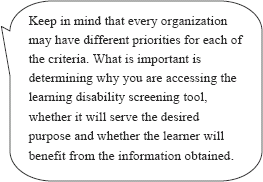
Rating criteria for the screening tools
The following is a list of criteria that were used by Literacy Link South Central. For each screening tool that was rated, we documented whether evidence was present or not to support each criterion. We did not assign a weight to each criterion because we felt that learners and programs have varying needs for the tools and it would therefore be impossible to determine the priorities for the literacy field.
- The screening tool should yield reliable information. The screening material should reliably measure indicators of potential learning disabilities and yield consistent results. (E.g. if the screening tool was given to the same person again, similar indicators of potential learning disabilities would be evident). Note: a low standard of error should be evident. Remember most tools may only have a maximum of 75% accuracy (75% of the time, the screening tool is correct in identifying a potential learning disability).
- The screening tool should be valid. The screening material adequately represents the full range of characteristics associated with learning disabilities. The screening material is consistent with what is currently known about learning disabilities. It covers a scope sufficient to provide an initial assessment in several areas such as language, motor, organization and social skills (look at what areas the screening questions cover or refer to the technical manual, if applicable, for a description of what areas are assessed with the instrument).
- The screening tool should be cost-effective. This should include the initial purchase and ongoing purchases of related materials such as question booklets, score sheets etc.
- The time required to conduct the screening procedures should be reasonable. It should be quick to administer, score, and interpret.
- The requirements for learning to use the screening tool should be reasonable. Requirements may range from reviewing the instructions or user manual to participating in a training session.